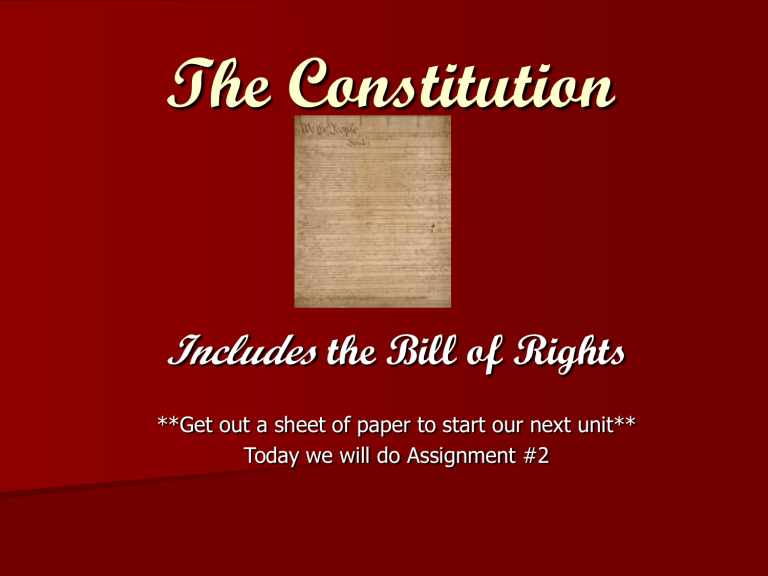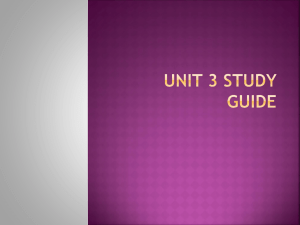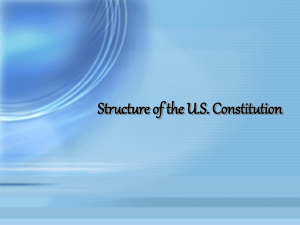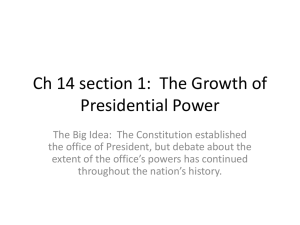Six Principals
advertisement

The Constitution Includes the Bill of Rights **Get out a sheet of paper to start our next unit** Today we will do Assignment #2 Warm-up Why do you think the Constitution of the U.S. is so important? What are the main ideas it is based on? The Constitution The Constitution is broad, general, nonspecific and open to interpretation – For Example: It says we have freedom of speech, yet that there are limitations on that freedom – It does not outline exactly what we can and cannot say. That needs to be determined by who…??? Six Principles of the U.S. Consitution **The Constitution is based on Six Principles** Popular Sovereignty Limited Government Judicial Review Separation of Powers Federalism Checks & Balances Popular Sovereignty The power of rule lies within the hands of the people Limited Government Government is not all powerful; has limited power Judicial Review The Judicial Branch (the courts) have the right and the responsibility to check the actions of the other two branches (executive/president & legislative/congress) to make sure they are constitutional Determined by court case Marbury v. Madison in 1803 – the court ruled that what the president did was unconsitutional (illegal) Separation of Powers (aka: The Three Branches) Executive commander in chief grants pardons makes treaties appoints executive officials, federal judges, and ambassadors recommends legislation & sees that all laws are executed supervises government employees establishes foreign policy Legislative lays Judicial and collects taxes Interprets the Constitution and the laws by hearing borrows money court cases regulates foreign and interstate commerce (trade of goods & services) coins money sets up inferior courts declares war raises, supports, maintains, disciplines & organizes the army & navy **See pg. 30 in your packet STOP, DROP & DRAW!! Draw one big circle map and write “The Six Principles of the Constitution” as your subject and using a different color to symbolize each principle draw a symbol for each principle we have covered so far. Create a key/legend to label which principle each color represents Federalism (aka: Govt. power is divided into central and state governments) Some National/Federal Powers Regulate Some Concurrent (Shared) Powers Some State Powers commerce Lay and collect taxes Create school systems Coin money Set up courts Enact marriage laws Raise an army and navy Make and enforce laws Establish local governments Establish a banking Collect taxes Borrow system money Protect public health Acquire territory Improve general Regulate local business welfare Control immigration Regulate trades and Charter banks and Professions Wage war another corporations Create state Make treaties Take land for public use constitutions Conduct elections **See pg. 30 in your packet STOP, DROP & DRAW!! Now draw a symbol to remember Federalism in a different color Add this color to your a key/legend and label which principle it represents Checks & Balances Branch Responsible Action Branch that checks How action is checked Executive Legislative Sends Troops Makes laws Legislative Executive Judicial Declares War Executive Vetoes laws Legislative Congress overrides veto with 2/3 vote Judicial Interprets laws Executive Grants pardons Executive Suggests annual Must approve Legislative federal budget Executive Appoints executive officials, federal judges, and ambassadors **See pg. 31 in your packet Recommends & Vetoes laws Interprets laws budget Legislative Senate must confirm with majority vote STOP, DROP & DRAW!! Now draw a symbol to remember Checks & Balances in a different color Add this color to your a key/legend and label which principle it represents Six Principles -- Review Individually create a tree map with six branches and first write the definition of each principle. Then provide three examples and a symbol for each – use your experience, brain and notes on pages 30-31! Six Principles of the U.S. Constitution Checks & Balances 3 Examples (notes) Judicial Review Popular Soverignty Court Case (notes) 3 Examples (brain, life exp.) Limited Government Separation of Powers Federalism 3 Examples (brain, life exp.) 3 Examples (notes) 3 Examples (notes) Making a JUMBO Tree Map Each of the Six Principles is evident in the writings of the Consitution After you complete your tree map, get into groups of 4 and create one large tree map on butcher paper that highlights some specific examples of the six principles in the Consitution. Six Principles Debrief Based on what you just learned about the Six Principles of the U.S. Constitution, do you agree or disagree with the Federalists that the Bill of Rights was not needed in the Constitution because it could not abuse power? The Constitution is the ‘Law of the Land’ Who remembers how our highest legal document is organized?? Outline of the U.S. Constitution: Preamble – Intro to Const. & states the Purposes of Government Article I – Legislative Branch II. Article II – Executive Branch III. Article III – J(g)udicial Branch IV. Article IV – Relations Among States Article V – Amendments (change) VI. Article VI – Supremacy of National Law VII. Article VII – Ratification (approve) Bill of Rights & 17 Additional Amendments (27) **LEGS Are Supremely Righteous Bill of Rights 1st 10 Amendments to the Constitution Outlines our personal, individual rights Create your own Student Bill of Rights List 10 personal and individual rights you think should be each students’ God-Given rights Amendment First Second Third Fourth Fifth Bill of Rights Explanation Freedom of religion, speech, press, assembly, & petition Right to possess weapons Citizens are not required to house soldiers during peacetime or war Protects people from unreasonable searches & seizures Protects the rights of the accused, includeing required indictments, double jeopardy, selfincrimination, due process, and just compensation of property Bill of Rights – cont. Amendment Sixth Seventh Eighth Ninth Tenth Explanation Guarantees a speedy and public trial, counsel, the confrontation by a witness and the right to call one’s own witness on their behalf Right to a jury trial in civil cases No excessive bail or cruel & unusual punishment Unenumerated Rights: Rights that are not mentioned in the Constitution the people may still have Federalism/State’s Rights:Powers not given to Additional Important Amendments Amendment Explanation Thirteenth Outlawed Slavery Fourteenth Equal rights of citizens (gave AA citizenship) Equal Protection Clause Due Process Clause First attempt to give AA males the right to vote Fifteenth Nineteenth Gave women the right to vote Twenty-Second Presidential Tenure (2 terms) Twenty-Fifth Presidential Succession The Bridge Map Vocabulary Development STOP, DROP & DRAW!! Now you try to relate two things Do 3 Bridge maps with your partner *************** Ideas: Your mom, your dog, food, clothes, music, skateboarding, sports, clubs…anything. Just Think!! Create a Constitution Book Get 17 pieces of paper, fold them in half and staple the book Include a cover page titled ‘The Consitution’ Include one page for each of the following: – Preamble – 7 Articles – 27 Amendments What to include on each page of your book… Title Short Description Symbol Bridge Map *For Amendments we did not cover, all you need is the Title and the Symbol Constitutional Amendment 2/3 vote in each house of Congress ¾ of the total state legislatures State National Governor President State Legislature State Senate State Assembly U.S. Congress Senate House of Representativ es State Supreme Court U.S. Supreme Court Executive – 3/4 out of 50 states Legislative – State legislatures is equivalent to the state congress Judicial WATCH BILL!!!









